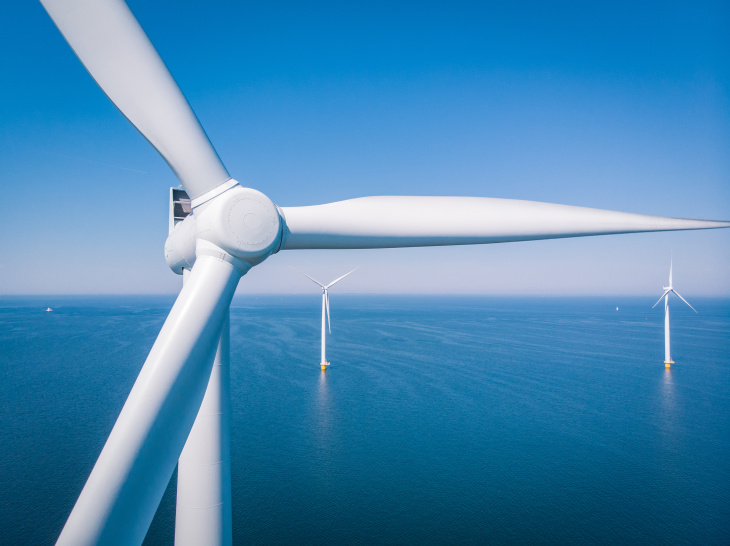The higher the wind turbine, the better
Wind farms in the North Sea can slow each other down and also affect marine life. Scientists at the Helmholtz Center Heron have now discovered that these effects do not necessarily have to increase with the future expansion of offshore wind energy. On the contrary: the trend is towards ever taller wind turbines, which obviously have less impact on the ocean. This can relieve the pressure on marine habitats and at the same time increase the electricity yield.

Wind turbines are getting taller and stronger. Image: IStock
Wind turbines are getting taller and stronger. In the early 2000s, the first 2-megawatt class turbines came onto the market, supplying electricity for the equivalent of around 3,000 households. Today, the tallest and most powerful turbines have around 15 megawatts. In a few years, this figure is set to rise to 20 megawatts. The European Union wants to use this to massively expand electricity production at sea, known as offshore wind power. There are currently wind turbines with a total output of 28 gigawatts in European waters, which is equivalent to around 50 nuclear power plant reactors. This figure is set to rise to 300 gigawatts by 2050.
In view of this enormous growth, scientists from Hereon have now investigated how the future wind farms consisting of 15-megawatt giants could affect their surroundings - both on the sea surface and on neighboring wind farms. The results, which the Hereon team led by climate researcher Dr. Naveed Akthar has now published in the journal Nature Scientific Reports, are surprising: Wind farms from 15-megawatt turbines have less of an impact on their surroundings than those from the much smaller 5-megawatt turbines.
In their study, the researchers assume that in future there will be comparatively few 15-megawatt wind turbines per square kilometer of wind farm area. Instead of many small turbines as before, there will be a few large ones in a wind farm. The reason for this is that the number of megawatts of wind power capacity that can be installed per square kilometer is regulated for marine areas in the European Union. This limit is reached more quickly with a few large turbines than with small ones.
Spatial changes in wind fields cause problems
Wind farms affect their surroundings because the rotation of the rotors causes air to swirl. This causes turbulence behind a wind farm. The wind speed is also lower there. For a wind farm located behind another wind farm, this means a lower electricity yield. As Naveed Akhtar and his colleagues described two years ago in a specialist article, wind turbines also affect marine life.
Using computer model calculations, they were able to show that the growth of planktonic algae in particular is altered. Behind a wind farm, it can be up to ten percent lower than in other marine areas. The reason for this is the decreasing wind and the increased turbulence behind the wind turbines. The energy transferred to the ocean decreases in these regions due to the reduction in wind speed. The spatially non-uniform wind fields near the water surface also generate compensatory movements in the ocean, which lead to vertical transport - so-called upwelling and downwelling - and can either increase or decrease plankton production.
As the Hereon team's current model calculations show, changes in the wind field at the water surface are smaller for a wind farm with 15 megawatt turbines. There are two main reasons for this. Firstly, the turbines are less close together. Secondly, they are higher. This means that the rotor does not come as close to the sea surface as with smaller turbines. "As far as the marine environment is concerned, this is good news for the expansion of offshore wind energy in European waters," says Naveed Akhtar. The larger turbines are also an advantage for electricity producers. Wind farms with a few tall turbines disturb the air flow less than many small turbines. The braking effect of a wind farm and the turbulence are lower. "All in all, this can increase the electricity yield in wind farms by two to three percent."
Unique view of the entire North Sea
The Hereon researchers' study is special because it presents the situation for the entire North Sea. "Usually, calculations of this kind only take into account the impact of individual wind turbines or just one wind farm," says Naveed Akhtar. "However, in view of the strong expansion in large areas of the North Sea, you have to look at the entire area. Wind farms have a long-distance effect that can reach 60 to 70 kilometers. To take all this into account, you have to look at the entire North Sea."
Further information
Kontakt
Institute for Coastal Systems - Analysis and Modeling | Helmholtz-Zentrum Hereon
Phone: T: +49 (0)4152 87-1009
Helmholtz-Zentrum Hereon
Helmholtz-Zentrum Hereon I Communication and Media
Phone: T: +49 (0)4152 87-1625
